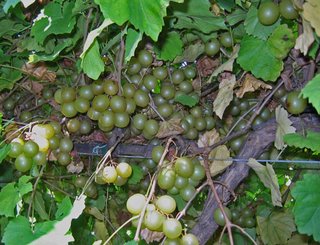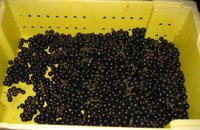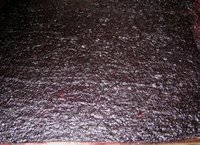Muscadine Grapes (The Southern Grape)
 Grapes! Well, that's what we do here. We have a small research vineyard tucked away in the hardwood forest of northern Orange county, NC. My husband has been breeding grapes since 1977 when he started on his masters at NCSU. He is privately funded. He has preserved and built upon the genetic foundation set in place by his predecessors as part of a century long quest in North Carolina to breed improved varieties of the native muscadine grape, Vitis rotundifolia Michx. With the progress made thus far, he is optimistic that new, multi-purpose cultivars will soon emerge that retain the heady floral aroma and flavor of the muscadine, yet bear texturally improved, wholly edible seedless berries on disease resistant ornamental vines with uniquely pigmented foliage that erupts into a stunning firestorm of fall colors.
Grapes! Well, that's what we do here. We have a small research vineyard tucked away in the hardwood forest of northern Orange county, NC. My husband has been breeding grapes since 1977 when he started on his masters at NCSU. He is privately funded. He has preserved and built upon the genetic foundation set in place by his predecessors as part of a century long quest in North Carolina to breed improved varieties of the native muscadine grape, Vitis rotundifolia Michx. With the progress made thus far, he is optimistic that new, multi-purpose cultivars will soon emerge that retain the heady floral aroma and flavor of the muscadine, yet bear texturally improved, wholly edible seedless berries on disease resistant ornamental vines with uniquely pigmented foliage that erupts into a stunning firestorm of fall colors. We grow a lot of varieties which are maintained as a gene pool. He is making some crosses for European style wine varieties in cooperation with another individual who grows them out but his primary focus is seedless muscadines.
What is a muscadine, you ask?

mus•ca•dine [MUHS-kuh-dihn]
n.
A woody vine (Vitis rotundifolia) of the southeast United States, bearing a musky grape used to make wine. Also called scuppernong by the locals (which is really a variety).
According to Wikipedia: muscadine
Muscadines (Vitis rotundifolia) are a grapevine species native to the present-day southeastern United States that has been extensively cultivated since the 16th Century. They are well adapted to their native warm and humid climate; they need fewer chilling hours than better known varieties and they thrive on summer heat.
Muscadines range from bronze to dark purple to black in color when ripe. Some consider the skins too tough to be edible. To eat the fruit raw, these people bite a small hole in the skin, then suck the thick gelatinous insides into their mouth, taking care to spit out the seeds embedded in it. Though mostly used fresh, muscadines have also been locally used in making home-brewed wine, juice, and jelly.
Although sharing the genus Vitis with the other grapevine species, muscadines belong to a separate subgenus, Muscadinia (the other grapevine species belong to Euvitis), and some have suggested giving it standing as a genus of its own. Some taxonomists have also suggested splitting two additional species off from Vitis rotundifolia: Vitis munsoniana and Vitis popenoei. All have 40 chromosomes, rather than 38, are generally not cross-compatible with other "Vitis" species, and most hybrids between the subgenera are sterile. A few, however, are at least moderately fertile, and have been used in breeding. The cultivar 'Southern Home', released by the University of Florida, contains both muscadine and Euvitis in its background. Unlike most cultivated grapevines, many muscadine cultivars are pistillate, and require a pollenizer to set fruit. A few, however, such as 'Carlos' and 'Noble', are perfect-flowered, and will produce fruit with their own pollen. They may also serve as pollenizers for pistillate cultivars, as well.
Wine
Muscadines have also been used for making commercial fine wines and port wines dating back to the 16th Century in and around St. Augustine, Florida. Today, there are vineyards throughout the Southeast vinting muscadine wines ranging from low to high quality. The typical muscadine wine is quite sweet and is therefore oftentimes considered a dessert wine, although some drier varieties exist. The term scuppernong refers to a large bronze type of muscadine originally grown in North Carolina; it is also used in making wine.
While not one of the most widely marketed varietals produced, the visibility of muscadine wine has benefited from the discovery that it provides even greater antioxidant health benefits than many better-known red wines.

What does all of this mean? Well, we have a lot of muscadine grapes out in the vineyard that grow no where else in the world! We actually do have the first seedless muscadine but it is not a marketable product. While it is productive, it is small, inconsistent in size of the cluster and does not have a dry scar. That means when you pull the grape off the cluster, it does not come off clean. In this case, it comes off with a bit of stem. This makes processing difficult. Still, we made raisins and fruit leather out of it.


We also process Noble, a dark variety that holds its color better than most others into jam and leather. We try a few others each year to see how they hold up.
For those who have never had a muscadine, it can be puzzling just how to eat them. Some people eat the skins. Many consider them too tough. All of them have seeds (except ours) and you can either swallow them or spit them out. Many, mostly non-southerners, raised on the mostly tasteless, though seedless Thompson Seedless grape, consider this offensive. Whatever! It would be a more widely accepted product if the skins were edible to all and it was seedless. There are several programs at universities (FL, Miss, GA) aimed at doing this. We are, to the best of my knowledge, the only privately funded effort to produce seedless muscadines in the US.
What you need to know about muscadines: They are healthy, vigorous and highly aromatic. When cutting the grass between the vineyard rows the incredible aroma fills the air announcing the area of the vineyard where they are planted. They have high yields (very productive) and are very disease resistant. They are sold in the fresh market and processed for wine. Most of the wines are sweetened to mask the bitterness that comes from the seeds and skins. They were also recently found to contain higher antioxidant values than any other fruit. Muscadines also contain ellagic acid, a compound thought to inhibit cancer. For more information, read this:Muscadines and Health facts
You can buy capsules that are derived from the skins/seeds in any health food store. Why you would, we do not know, when you can just eat the grapes or natural products made from them. They are very flavorful, highly aromatic and have a wonderful flavor. And before you know it, you'll be able to eat the whole thing! We are optimistic that within a few years a viable seedless muscadine will be commercially available.
What are we doing with them other than eating them and sharing them? We are making jam and leather to keep the skins in the final product.
If you see them, try them, even if you have to spit. Their flavor is like no other grape and within the next few years, you won't even have to spit!

For recipes for Muscadine Grape Jam check out the the recipes of the week on our website. Swank Recipes. Miscellaneous recipes also has the muscadine fruit leather recipe. It's healthy fruit rollups with no added sugar!
This is being submitted to weekend herb blogging hosted this weekend by Sher of What did you eat? so the whole world will learn about muscadines (well the whole world of wonderful weekend herb bloggers). Cheers!




6 Comments:
At 8:47 AM, Kalyn Denny said…
Kalyn Denny said…
Very interesting. I know practically nothing about grapes, so I learned a lot.
At 11:01 AM, Anonymous said…
Anonymous said…
I love learning this! I am not sure if that is what grows wild in our woods. I always call them fox grapes.
I didn't know much about them except they make a great juice!
At 2:09 PM, JMom said…
JMom said…
oh you just answered my hubby's question! As soon as we got home and were bombarding him with tales of your vineyard, one of his questions was, "I wonder if her husband cross breeds them with european varieties?" Didn't I tell you he would love your place? :D He also asked how your husband kept the different varieties from cross polinating. I told him it had something to do with hanging bags from the plants. hahaha!!! sorry, I know you mentioned how, but I think it didn't sink in my old brain. I do remember the bags :)
Thanks again for giving us a taste of these grapes, we just love them! AND, I walked into the kitchen this morning to the most glorious smell! I just love the sweet scent. Now I'm off to get your recipe for the leather (fruit roll up) the girls loved it!
At 10:25 PM, Anonymous said…
Anonymous said…
Kalyn, C'Pot and JMom, Thanks for your comments! If you've never had them, you need to try them. One day, they will be more widely available and we have ones on one else does. As for JMom, she had I had our first meeting, after meeting on the the net and sharing food blogs. We are neighbors and met for the first time this weekend and she got to try them first hand with her beautiful children. It was great! If you're in the area come by or if REALLY interested, I'll send you a sampler.
Thanks again!
At 9:08 PM, sylvie1950 said…
sylvie1950 said…
A family friend of ours in Greensborough makes Muscadine wine which by the way tastes great. Thanks for the post as it opened my eyes to a lot about this grape.
At 4:07 PM, Anonymous said…
Anonymous said…
could you tell me what type of grape would grow best in miami fla tks
Post a Comment
<< Home